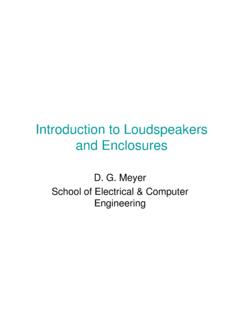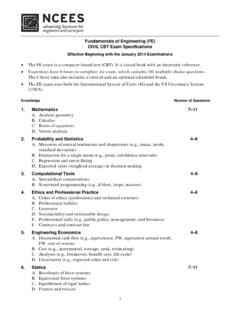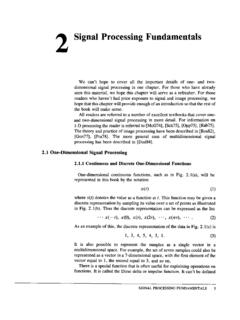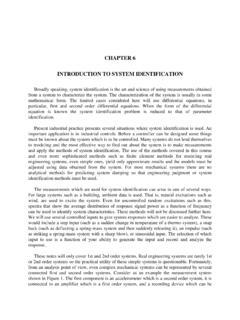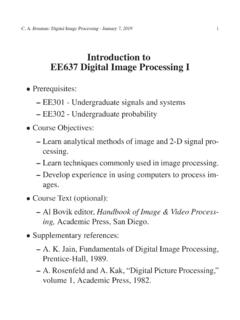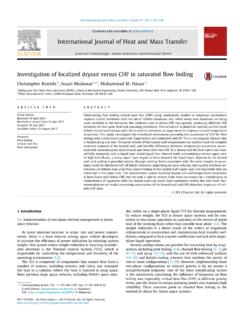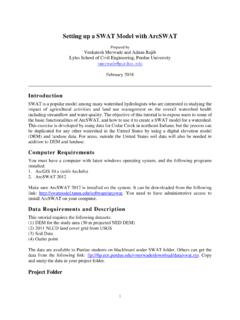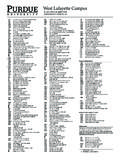Transcription of Lecture 8: AES: The Advanced Encryption Standard Lecture ...
1 Lecture 8: AES: The Advanced Encryption Standard Lecture Notes on Computer and Network Security . by Avi Kak May 7, 2020. 12:45 Noon c 2020 Avinash Kak, purdue University Goals: To review the overall structure of AES and to focus particularly on the four steps used in each round of AES: (1) byte substitution, (2) shift rows, (3) mix columns, and (4) add round key. Python and Perl implementations for creating the lookup tables for the byte substitution steps in Encryption and decryption. Python and Perl implementations of the Key Expansion Algorithms for the 128 bit, 192 bit, and 256 bit AES.
2 Perl implementations for creating histograms of the differentials and for constructing linear approximation tables in attacks on block ciphers. CONTENTS. Section Title Page Salient Features of AES 3. The Encryption Key and Its Expansion 10. The Overall Structure of AES 12. The Four Steps in Each Round of Processing 15. The Substitution Bytes Step: SubBytes and 19. InvSubBytes Traditional Explanation of Byte Substitution: 22. Constructing the 16 16 Lookup Table Python and Perl Implementations for the AES 27. Byte Substitution Step The Shift Rows Step: ShiftRows and InvShiftRows 31.
3 The Mix Columns Step: MixColumns and 33. InvMixColumns The Key Expansion Algorithm 36. The Algorithmic Steps in Going from one 4-Word 40. Round Key to the Next 4-Word Round Key Python and Perl Implementations of the Key 45. Expansion Algorithm Differential, Linear, and Interpolation Attacks on 56. Block Ciphers Homework Problems 90. 2. Computer and Network Security by Avi Kak Lecture 8. Back to TOC. SALIENT FEATURES OF AES. AES is a block cipher with a block length of 128 bits. AES allows for three different key lengths: 128, 192, or 256 bits. Most of our discussion will assume that the key length is 128.
4 Bits. [With regard to using a key length other than 128 bits, the main thing that changes in AES is how you generate the key schedule from the key an issue I address at the end of Section The notion of key schedule in AES is explained in Sections and ]. Encryption consists of 10 rounds of processing for 128-bit keys, 12 rounds for 192-bit keys, and 14 rounds for 256-bit keys. Except for the last round in each case, all other rounds are identical. Each round of processing includes one single-byte based substitution step, a row-wise permutation step, a column-wise mixing step, and the addition of the round key.
5 The order in which these four steps are executed is different for Encryption and decryption. 3. Computer and Network Security by Avi Kak Lecture 8. To appreciate the processing steps used in a single round, it is best to think of a 128-bit block as consisting of a 4 4 array of bytes, arranged as follows: . byte0 byte4 byte8 byte12 . byte1 byte5 byte9 byte13.. byte byte6 byte10 byte14.. 2.. byte3 byte7 byte11 byte15. Notice that the first four bytes of a 128-bit input block occupy the first column in the 4 4 array of bytes. The next four bytes occupy the second column, and so on.
6 The 4 4 array of bytes shown above is referred to as the state array in AES. [If you are trying to create your own implementation of AES in Python, you will find following statement, which uses the notion of list comprehension in Python, very useful for creating an initialized structure that looks like the state array of AES: statearray = [[0 for x in range(4)] for x in range(4)]. Next, try the following calls in relation to the structure thus created: print statearray print statearray[0]. 4. Computer and Network Security by Avi Kak Lecture 8. print statearray[2][3].]
7 Block = range(128). for i in range(4): for j in range(4): statearray[j][i] = block[32*i + 8*j:32*i + 8*(j+1)]. for i in range(4): for j in range(4): print statearray[i][j], " ", This is a nice warm-up exercise before you start implementing AES in Python.]. AES also has the notion of a word. A word consists of four bytes, that is 32 bits. Therefore, each column of the state array is a word, as is each row. Each round of processing works on the input state array and produces an output state array. The output state array produced by the last round is rearranged into a 128-bit output block.
8 Unlike DES, the decryption algorithm differs substantially from the Encryption algorithm. Although, overall, very similar steps 5. Computer and Network Security by Avi Kak Lecture 8. are used in Encryption and decryption, their implementations are not identical and the order in which the steps are invoked is different, as mentioned previously. AES, notified by NIST as a Standard in 2001, is a slight variation of the Rijndael cipher invented by two Belgian cryptographers Joan Daemen and Vincent Rijmen. [Back in 1999, the Rijndael cipher was one of the five chosen by NIST as a potential replacement for DES.]
9 The other four were: MARS from IBM; RC6 from RSA Security; Serpent by Ross Anderson, Eli Biham, and Lars Knudsen; and Twofish by a team led by the always-in-the-news cryptographer Bruce Schneier. Rijndael was selected from ]. these five after extensive testing that was open to public. Whereas AES requires the block size to be 128 bits, the original Rijndael cipher works with any block size (and any key size). that is a multiple of 32 as long as it exceeds 128. The state array for the different block sizes still has only four rows in the Rijndael cipher. However, the number of columns depends on size of the block.
10 For example, when the block size is 192, the Rijndael cipher requires a state array to consist of 4 rows and 6. columns. As explained in Lecture 3, DES was based on the Feistel network. On the other hand, what AES uses is a substitution-permutation network in a more general sense. Each round of processing in AES involves byte-level substitutions followed by word-level permutations. Speaking 6. Computer and Network Security by Avi Kak Lecture 8. generally, DES also involves substitutions and permutations, except that the permutations are based on the Feistel notion of dividing the input block into two halves, processing each half separately, and then swapping the two halves.

